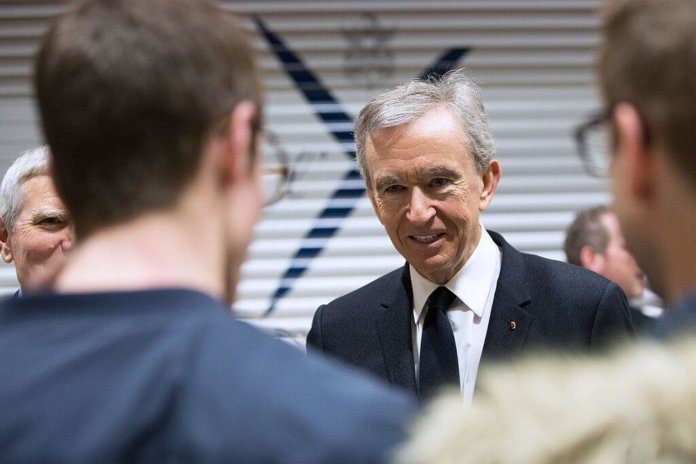
Long before the 1987 merger that gave life to French luxury goods giant LVMH was the births of two family businesses Moët et Chandon and Louis Vuitton. Moët et Chandon was founded when Claude Moët and his son Claude-Louis started a wine business called Moët et Cie, running the company together and establishing its old world heritage before passing it down to Claude’s grandson Jean-Rémy in 1792.
Louis Vuitton, a solo venture of the company’s namesake, Louis Vuitton, started as a small packing and luggage company that over time grew to include Louis’s son, Georges. It was Georges who stretched the company beyond the borders of France and into the international marketplace when he opened the first Louis Vuitton store in London in 1885. The foundations laid by the Vuitton father-son duo paved the way for another father and son, Jean and Bernard Arnault to take these founders’ old world crafts and turn the companies into the worldwide luxury brand that we know today.
Birth of LVMH
In 1971, Frenchman Bernard Arnault graduated from university and joined his father Jean’s successful construction company called Ferret-Savinel. By 1978, after years of upward mobility and successful restructuring under his father’s watch, Arnault succeeded Jean as Chairman of Ferrel-Savinel and eventually went on to reorganize the Financière Agache holding company, owner of the ailing House of Dior by Christian Dior. As part of this reorganization, Arnault set his eye on developing a strategy that would not only reinvigorate the House of Dior brand, but also create a new paradigm in the luxury goods industry.
In 1988, shortly after the merger between Moët Hennessy and Louis Vuitton resulted in the creation of LVMH, Arnault methodically implemented his vision for luxury goods with quick, opportunistic action when Louis Vuitton’s president invited him to invest in the new company’s stock. This invitation, a colossal mistake on the part of the president who hoped his invitation would solidify an alliance with Arnault and give him greater control of the newly formed company, allowed Arnault to channel his resources and purchase far more shares than expected, giving him a 43.5% stake in LVMH.
To Each His Own
With his claim staked out, Arnault was appointed Chairman and CEO of LVMH in 1989 and immediately set his sights on expanding the new company. What followed in the next two decades was an impressive sweep of luxury goods companies including Dom Pérignon, Givenchy, Fendi, Tag Heur, Sephora and sixty five other well-established brands worldwide.
With each acquisition, Arnault insisted on retaining each brands’ unique identity and name while operating under the umbrella of LVMH. This strategy gave Arnault the freedom to refine brands and refresh their images while maintaining their heritage and followership. The insistence on running the individual brands autonomously gave LVMH a wider swath of the marketplace, keeping consumers loyally engaged with their favorite products without realizing how many of them belong to the same parent company. It is also why each brand, internally governed, was able to uphold its unique identity and maintain its reputation of quality.
Rutheless Expansion
While many of Arnault’s acquisitions came easily to LVMH, not every one of his targets went down without a fight. Two of his greatest failures in acquisition to date followed his attempts to take over Gucci in 2001 and Hermes in 2014. In both cases, Arnault set out to buy small quantities of each brand’s stock, while insisting that LVMH had no intention of expanding said ownership.
Like a wolf in sheep’s clothing however, Arnault began aggressively pursuing the full acquisition of Gucci shortly after purchasing shares in the company, alerting Gucci’s leadership to his plan. Gucci responded by offering itself up to LVMH and Arnault for $85 million, an offer Arnault refused. This refusal bought Gucci time to protect itself against Arnault’s advances with swift legal action and creating an alliance with Francois Pinault, chairman of LVMH’s archrival Kering, who ultimately bought out the shares owned by LVMH over a two year period.
Hermes, on the other hand, endured a much longer, more arduous defense against LVMH after a small batch of its stock was quietly purchased in 2001. Perhaps having learned from his failure with Gucci, Arnault crafted a slower advance on Hermes, purchasing chunks of the company over the course of a decade without Hermes’s knowledge. In 2010, LVMH announced to much surprise that it had acquired a cumulative 14.2% stake in Hermes gained partly via derivatives that allowed it to not declare its holding, causing Hermès CEO Patrick Thomas to declare, “If you want to seduce a beautiful woman, you don’t start by raping her from behind”. The announcement kicked off years of legal battles and criminal complaints, which came to a close in 2014 when Arnault relinquished most of his $7.5 billion holding in Hermes.
A Family Affair
Despite the controversies, Bernard Arnault’s commitment to building a luxury empire has propelled LVMH to become the largest luxury good producer in the world today, and his successful model of brand integration has gone on to inspire other luxury companies such as French conglomerate Kering and Swiss giant Richemont into doing the same. And after twenty seven years of growth under his leadership, his successors are now looking to take on the family heritage, Arnault’s daughter Delphine joined LVMH in 2000 and after taking on a variety of roles including management board chairperson and deputy managing director of Christian Dior, was appointed executive vice president of Louis Vuitton, a position she continues to hold today.
Delphine is not the only Arnault offspring to lend a hand in LMVH’s success. Her younger brother Antoine joined the company shortly after Delphine and quickly climbed the ladder as his father and sister had before him. Today, he is the CEO of luxury menswear brand Berluti, which has grown under his watch from $45 million a year to $130 million in sales.
Rumors are circulating that 67 year old Arnault will soon retire as Chairman and CEO of LVMH and place his company in the capable hands of Delphine with Antoine’s support. Time will tell if this is true, but one thing is certain: the strategic growth of LVMH under Arnault’s watch ensures that the brand will be a prominent force in luxury goods for generations to come.









